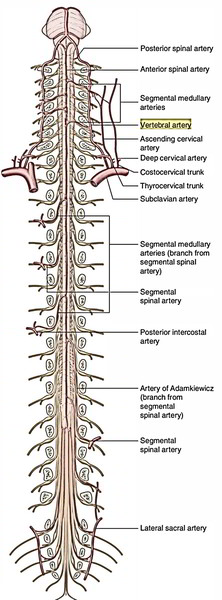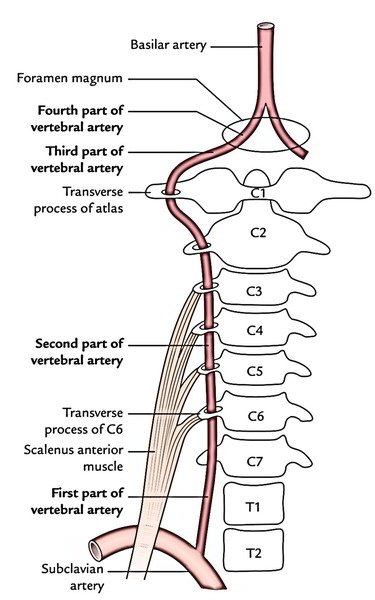The vertebral artery is among the main arteries which supplies the brain.
It’s the first and largest branch of the very first part of the subclavian artery.
Origin, Course and Conclusion
The vertebral artery originates from the upper aspect of the initial part of the subclavian artery, runs vertically upwards to goes into the foramen transversarium of the transverse process of C6. Subsequently it goes through the foramen transversaria of the upper 6 cervical vertebrae.
After appearing from the foramen transversarium of C1, it winds backwards around the lateral mass of the atlas and enters the cranial cavity via foramen magnum.
In the cranial cavity, it links together with the vertebral artery ofthe opposite side at the lower border of the pons to create thebasilar artery.
Parts
The vertebral artery is split into 4 parts, viz.
- First (cervical) part-goes from origin to foramen transversarium of C6 vertebra. This part is located in the scalenovertebral triangle.
- Second (vertebral) part-is located inside the foramen transversaria of upper 6 cervical vertebrae.
- Third (suboccipital) part-goes from foramen transversarium of C1 vertebra to the foramen magnum of skull. This part is located inside the suboccipital triangle.
- Fourth (intracranial) part-goes from foramen magnum to the lower border of the pons.
Branches
In the neck (cervical branches).
- Spinal branches: They originate from the second (vertebral) part and goes into the vertebral canal via intervertebral foramina to supply the upper 5 or 6 cervical parts of the spinal cord.
- Muscular branches: They originate from the first and third parts of the vertebral artery. Those from the first part, supply deep muscles of the neck and those from the 3rd part, supply the muscles of the suboccipital triangle.
In the cranial cavity (cranial branches).
They originate from the 4th part. These are:
- Meningeal branches.
- Posterior spinal artery.
- Anterior spinal artery.
- Posterior inferior cerebellar artery.
- Medullary branches.
Clinical Significance
Subclavian steal syndrome: If there’s obstruction of the subclavian artery proximal to the origin of vertebral artery, some amount of blood from opposite vertebral artery will pass in a retrograde manner to the subclavian artery of the affected side via the vertebral artery of that side to supply the collateral circulation to the upper limb on the side of lesion. So there takes place a kind of larceny of blood of brain by the subclavian artery of the affected side. For this reason, the name subclavian steal syndrome.



 (59 votes, average: 4.49 out of 5)
(59 votes, average: 4.49 out of 5)